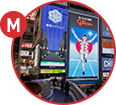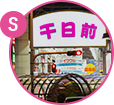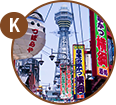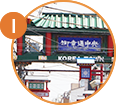
Osaka Museum of Housing and Living –
Time Travel to Edo-period Osaka
2024.06.14


Written by: Bie(Bie)
● First Museum to Focus on Osaka's History & Culture
สวัสดี! I’m Bie. I’m from Thailand.
I fell in love with Japan after visiting this beautiful country♪ I like to travel and have seen a lot of Japan, but the City of Osaka never seizes to amaze me.

Today, I’m visiting the Osaka Museum of Housing and Living located near Osaka Metro’s Tenjinbashisuji 6-chome Station!

Getting to the museum is quick and easy–simply follow the signage from Exit No. 3 and take the No. 4 elevator to the museum entrance on the 8th floor. (※Important: Don’t take the other elevators. Only the No. 4 elevator takes you to the 8th floor.)

For those who’ve been shopping for souvenirs (which is a natural thing to do in Osaka), free coin operated lockers are conveniently located next to the front counter on the 8th floor so you can enjoy the museum hands free. You will need one 100 yen coin to use the locker. (You will get it back when you get your bag out of the locker.)

Although you enter the museum on the 8th floor, you’re guided to start your tour up on the 10th floor–where you have a bird’s eye view of the Edo-period Osaka–then go down to the 9th then to the 8th floors as you visit. I was excited to see what the museum had to offer!
[Ad]
Klook.com
● Multilingual Services Available♪

As soon as I entered the museum, I noticed a rack full of museum guide brochures written in multiple languages including Japanese, English, Korean, Traditional Chinese, and Simplified Chinese. The floor map in the brochure is useful in finding where everything is.

In addition to the brochure, signs with various icons help everyone–including those who do not read Japanese–understand the museum rules.

On the 9th floor, you can find self-guided audio tours in Japanese, English, Korean, and Mandarin Chinese, available for 100 yen only for those who want to learn in depth the history and culture of life in Osaka.
● Travel to the 19th Century Osaka

Wow. As I stepped into the exhibit area on the 9th floor, I found a world completely different from the modern city where I just came from. Was I still in Osaka?
Yes, sort of… I was standing in the middle of Osaka-machi 3-chome, a life-size replica of Osaka City from 200 years ago! Here, you can literally walk the streets of Edo-period Osaka like the samurais do in the movies and experience the life back then♪ It felt quite real indeed.

It was as if I time-travelled back to the old Osaka. Everywhere I looked, it was undoubtedly the charming 19th century Japan. Which also meant that every shot I took made a nice retro picture.

Exhibits are detailed and helped me imagine what life was like as an Osakan merchant.
Shops that line the main street vary and include ofuro-ya (bath house), ningyo-ya (doll shop), a book store, a pharmacy, a kimono shop, an import goods store– just the same as in modern day Osaka (think Tenjinbashisuji Shopping Street).
Deep into the alley was a residential area where rowhouses housed ordinary citizens. It was somewhat strange but interesting to witness first-hand the life of Osakans 200 years ago.
Exhibits included everyday tools and gadgets. I had to guess what some of them were, but it was apparent they paid a lot of attention to detail–I even found an intentionally broken plate.
Each exhibit had English translation available, helping visitors not only experience the ambience but also understand how the room was used.

Among the various displays of establishments, my favorite was the doll shop.
Chinese zodiac dolls and hariko (Japanese traditional papier‐mâché crafts) were really cute♡ Lots of colorful and very traditionally Japanese dolls were on display.
I even found toys that children used to play with back in the Edo period. I tried a few, but it was harder than I expected. lol

Here’s a “Surikogi Tombo” dragon fly. You take the stick and rasp it against the jagged stick, and the propeller at the end of the stick begins to turn. Except it didn’t…it was my first time and I struggled. (lol) People around me cheered for me and I was excited when it finally turned! I didn’t quite understand the mechanics of it, but it was a fun toy.
Other toys included juggling bean bags, tops, and patapata (literally “pitter patter”; Japanese version of the Jacobs Ladder toy) and will no doubt be welcomed by little visitors! Thailand is known as the Land of Smiles. I feel these toys from old Japan bring smiles just like my home country does.

At the ofuro-ya bathhouse theater, a success story of an Osakan townsman during the Edo period was unfolding.
It was in Japanese, with subtitles in English, Chinese (Traditional & Simplified) and Korean. Telling (or showing) a story, instead of merely giving an explanation, is a clever way to describe the lives of ordinary Osakans. It’s easy to understand, and parts of it even made me laugh.
The short film plays every 20 minutes and the theme changes regularly.
● The Life in Good Old Osaka

Another thing that makes this unique exhibit excellent and real is its production. Using light and sound effects, the scenery changes throughout the day and you can feel the time shifting.

Listen carefully, and you will hear the rooster go Cockadoodledoo in the morning. After lunchtime, you hear rain and thunder. A dog howls in the evening and the crickets chirps at night. These are the sounds Osakans used to hear in the course of the day♪ In those old times, with no cars or trains, the sounds of nature were normal part of the day. What a relaxing and soothing time it must’ve been.
After the rain, a rainbow appears in the sky and, at night, the moon rises. At this museum, you are truly using your five senses to feel and experience the good old Osaka.

I liked the Osaka-machi at night. The sky turned dark purple, and the soft orange lanterns created an exquisitely Japanese ambience.

If you pay attention to detail, you will make interesting discoveries. I love furry friends♡
and the two dogs I found in the alley are named Ten and Roku. Get it? Ten-Roku stands for Tenjinbashisuji 6 (pronounced “roku”) chome, where the museum is located! lol
● Panoramic View of Old Osaka

Down on the 8th floor are intricate models of Osaka City encompassing the Meiji Restoration through Taisho and Showa Eras.

Don’t be shy and take a close look. They look very real with details and movements, and you can get a good feel of the life then. Can you find the little boy walking down the street with his mom and has fallen on his bum? lol

Life is vibrant in this city, despite it being merely a model of what it used to be.
Kids playing soccer, students rushing to school, a man helping with directions, dads having a drink…the world depicted is much like the world I live in and I felt close to those townspeople.

Learn the evolution of Osaka through stories, examine Osaka’s famous Tenjin Matsuri Festival in details, and–my favorite–see the complete view of Tsutenkaku Tower.
In all honesty, it was somewhat strange to see the model of the city I know. But, looking at these models, I realized the old Tsutenkaku Tower lives within the current Tsutenkaku Tower, and I felt as if I was a witness to the history of this city.
● Perfect Place to Go Even on a Rainy Day

Since it’s an indoor museum, the Osaka Museum of Housing and Living makes a perfect spot to visit even on a rainy day☆
In addition to the exhibits introduced in this article, special exhibits, workshops, and events are held at the museum. Check the website before you go and you’ll likely find an interesting exhibit or event♪
The Osaka Museum of Housing and Living is a unique way to experience Osaka. Take a journey into the good old Osaka and come away with a deeper knowledge of this city and cool Edo-period Japan photos!
*This information is current as of March 3rd, 2023. Please understand that some details may have changed.
[Ad]
Klook.com
Spots Introduced
Osaka Museum of Housing and Living
[Access] Near Tenjimbashisuji 6-chome Station Exit No. 3 on the Tanimachi and Sakaisuji Lines
[Hours] 10:00-17:00 (Last admission at 16:30)
[Closed] Tuesday, New Year holidays
Recommended Plans

2025 Count Down the Japanese Way—
The Temple Bell on New Year’s Eve in Osaka
Already, 2025 is coming to an end and the beginning of a new year is …
2025.12.26

Start the New Year with Osaka’s Toka Ebisu Festival!
Literally “10th day Ebisu”, the Toka Ebisu Festival is always a big event! The three-day …
2025.12.19

You Can Go in December!
Hatsumode - Start the New Year with Osaka Metro
The night of Near Year’s eve into the morning of the New Year’s Day is a …
2025.12.12
Tenjimbashisuji 6-chome
Tenjimbashisuji 6-chome
















